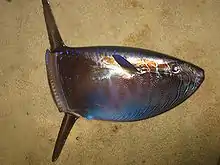Slender sunfish
The slender sunfish (Ranzania laevis) is a mola of the family Molidae, the only extant member of the genus Ranzania,[1] found globally in tropical and temperate seas. Its length is up to 1 m (3.3 ft). Several stranding and mass stranding events have occurred on beaches near Albany, Western Australia.[2][3]
| Slender sunfish | |
|---|---|
 | |
| Scientific classification | |
| Kingdom: | |
| Phylum: | |
| Class: | |
| Order: | |
| Family: | |
| Genus: | Ranzania Nardo, 1840 |
| Species: | R. laevis |
| Binomial name | |
| Ranzania laevis (Pennant, 1776) | |
The first South Australian specimen was found at Aldinga in 1944.[4] A cast was made from it, and a replica was made, painted and prepared for display at the South Australian museum that year.[5] Several other individuals have stranded in South Australia at Port Willunga, Netley[6] and West Beach with the latter successfully returned live to deeper water.[7]
The body of this fish gives the appearance of the side view of a larger shark (an optical illusion underwater). This is most likely to ward off any would be predators.
Gallery
 Close-up of the head of a slender sunfish
Close-up of the head of a slender sunfish Slender sunfish in Napili Bay, Maui, Hawaii
Slender sunfish in Napili Bay, Maui, Hawaii
References
- Matsuura, K. (2014): Taxonomy and systematics of tetraodontiform fishes: a review focusing primarily on progress in the period from 1980 to 2014. Ichthyological Research, 62 (1): 72-113.
- "A Marine Rarity. Shoal of Stranded Sunfish". The West Australian. 1928.
- "Albany Sunfish. Rare Fish Found Locally". Albany Advertiser. 1941.
- "Rare Sunfish Found At Aldinga Beach". Advertiser (Adelaide, SA : 1931 - 1954). 1944-06-20. p. 6. Retrieved 2019-06-25.
- "Sunfish Which Is Rare And Distinctly Unfishy". Advertiser (Adelaide, SA : 1931 - 1954). 1944-09-13. p. 4. Retrieved 2019-06-25.
- "Sunfish sightings in South Australia". Marine Life Society of South Australia Inc. 2014-08-09. Retrieved 2019-06-25.
- "Slender Mola (Ranzania laevis)". iNaturalist.org. Retrieved 2019-06-25.
Abu El-Regal and El-Moselhy. 2013. The first record of slender sunfish, Ranzania laevis from the Red Sea. Journal of Fish Biology. Journal of Fish Biology 83(5):1425-9
DOI: 10.1111/jfb.12226
